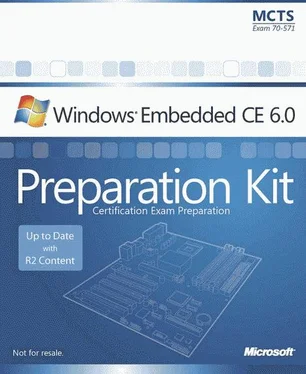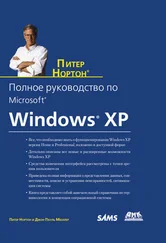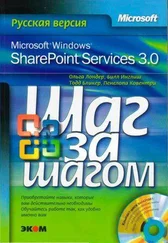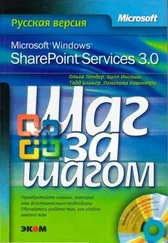Nicolas Besson - Microsoft Windows Embedded CE 6.0 Exam Preparation Kit
Здесь есть возможность читать онлайн «Nicolas Besson - Microsoft Windows Embedded CE 6.0 Exam Preparation Kit» весь текст электронной книги совершенно бесплатно (целиком полную версию без сокращений). В некоторых случаях можно слушать аудио, скачать через торрент в формате fb2 и присутствует краткое содержание. Город: Redmond, Год выпуска: 2008, Издательство: Microsoft, Жанр: Руководства, ОС и Сети, Программы, на английском языке. Описание произведения, (предисловие) а так же отзывы посетителей доступны на портале библиотеки ЛибКат.
- Название:Microsoft Windows Embedded CE 6.0 Exam Preparation Kit
- Автор:
- Издательство:Microsoft
- Жанр:
- Год:2008
- Город:Redmond
- ISBN:нет данных
- Рейтинг книги:5 / 5. Голосов: 1
-
Избранное:Добавить в избранное
- Отзывы:
-
Ваша оценка:
- 100
- 1
- 2
- 3
- 4
- 5
Microsoft Windows Embedded CE 6.0 Exam Preparation Kit: краткое содержание, описание и аннотация
Предлагаем к чтению аннотацию, описание, краткое содержание или предисловие (зависит от того, что написал сам автор книги «Microsoft Windows Embedded CE 6.0 Exam Preparation Kit»). Если вы не нашли необходимую информацию о книге — напишите в комментариях, мы постараемся отыскать её.
Microsoft Windows Embedded CE 6.0 Exam Preparation Kit — читать онлайн бесплатно полную книгу (весь текст) целиком
Ниже представлен текст книги, разбитый по страницам. Система сохранения места последней прочитанной страницы, позволяет с удобством читать онлайн бесплатно книгу «Microsoft Windows Embedded CE 6.0 Exam Preparation Kit», без необходимости каждый раз заново искать на чём Вы остановились. Поставьте закладку, и сможете в любой момент перейти на страницу, на которой закончили чтение.
Интервал:
Закладка:
Stream drivers, on the other hand, expose a well-known set of functions that enable Device Manager to load and manage these drivers. For Device Manager to interact with a stream driver, the driver must implement the Init, Deinit, Open, Close, Read, Write, Seek, and IOControl functions. In many stream drivers, the Read, Write, and Seek functions provide access to the stream content, yet not all peripherals are stream devices. If the device has special requirements beyond Read, Write, and Seek, you can use the IOControl function to implement the required functionality. The IOControl function is a universal function that can accommodate any special needs of a stream device driver. For example, you can extend a driver's functionality by passing a custom IOCTL command code and input and output buffers.<\/p>
Native drivers must implement different types of interfaces depending on the nature of the driver. For complete information about the supported driver types, see the section "Windows Embedded CE Drivers" in the Windows Embedded CE 6.0 Documentation, available on the Microsoft MSDN® Web site at http://msdn2.microsoft.com/en-us/library/aa930800.aspx<\/em> .<\/p> <\/cite>
Monolithic vs. Layered Driver Architecture<\/p> <\/div>
Native and stream drivers only differ in terms of the APIs they expose. You can load both types of drivers during system startup or on demand, and both types can use a monolithic or layered design, as illustrated in Figure 6-1.<\/p>
Monolithic Drivers<\/p> <\/div>
A monolithic driver relies on a single DLL to implement both the interface to the operating system and applications, and the logic to the hardware. The development costs for monolithic drivers are generally higher than for layered drivers, yet despite this disadvantage, monolithic drivers also have advantages. The primary advantage is a performance gain by avoiding additional function calls between separate layers in the driver architecture. Memory requirements are also slightly lower in comparison to layered drivers. A monolithic driver might also be the right choice for uncommon, custom hardware. If no layered driver code exists that you could reuse, and if this is a unique driver project, you might find it advantageous to implement a driver in a monolithic architecture. This is especially true if reusable monolithic source code is available.<\/p>
Layered Drivers<\/p> <\/div>
In order to facilitate code reuse and lower development overhead and costs, Windows Embedded CE supports a layered driver architecture based on model device driver (MDD) and platform device driver (PDD). MDD and PDD provide an additional abstraction layer for driver updates and to accelerate the development of device drivers for new hardware. The MDD layer contains the interface to the operating system and the applications. On the hardware side, MDD interfaces with the PDD layer. The PDD layer implements the actual functions to communicate with the hardware.<\/p>
When porting a layered driver to new hardware, you generally do not need to modify the code in the MDD layer. It is also less complicated to duplicate an existing layered driver and add or remove functionality than to create a new driver from scratch. Many of the drivers included in Windows Embedded CE take advantage of the layered driver architecture.<\/p>
The MDD/PDD architecture can help driver developers save time during the development of driver updates, such as providing quick fix engineering (QFE) fixes to customers. Restricting modifications to the PDD layer increases development efficiencies.<\/p> <\/cite>
Lesson Summary<\/p> <\/div>
Windows Embedded CE supports native and stream drivers. Native drivers are the best choice for any devices that are not stream devices. For example, a display device driver must be able to process data in arbitrary patterns and is therefore a good candidate for a native driver. Other devices, such as storage hardware and serial ports, are good candidates for stream drivers because these devices handle data primarily in the form of ordered streams of bytes as if they were files. Both native and stream drivers can use either the monolithic or layered driver design. In general, it is advantageous to use the layered architecture based on MDD and PDD because it facilitates code reuse and the development of driver updates. Monolithic drivers might be the right choice if you want to avoid the additional function calls between MDD and PDD for performance reasons.<\/p>
Lesson 2: Implementing a Stream Interface Driver<\/p> <\/div>
On Windows Embedded CE, a stream driver is a device driver that implements the stream interface API. Regardless of hardware specifics, all CE stream drivers expose the stream interface functions to the operating system so the Device Manager of Windows Embedded CE can load and manage these drivers. As the name implies, stream drivers are suitable for I/O devices that act as sources or sinks of streams of data, such as integrated hardware components and peripheral devices. It is also possible for a stream driver to access other drivers to provide applications with more convenient access to the underlying hardware. In any case, you need to know the stream interface functions and how to implement them if you want to develop a fully functional and reliable stream driver.<\/p>
After this lesson, you will be able to:<\/strong> <\/p>
■ Understand the purpose of Device Manager.<\/p>
■ Identify stream driver requirements.<\/p>
■ Implement and use a stream driver.<\/p>
Estimated lesson time: 40 minutes.<\/strong> <\/p> <\/cite>
Device Manager<\/p> <\/div>
The Windows Embedded CE Device Manager is the OS component that manages the stream device drivers on the system. The OAL (Oal.exe) loads the kernel (Kernel.dll), and the kernel loads Device Manager during the boot process. Specifically, the kernel loads the Device Manager shell (Device.dll), which in turn loads the actual core Device Manager code (Devmgr.dll), which again is in charge of loading, unloading, and interfacing with stream drivers, as illustrated in Figure 6-2.<\/p>
Driver Naming Conventions<\/p> <\/div>
For an application to use a stream driver through the file system, the stream driver must be presented as a file resource so that the application can specify the device file in a CreateFile call to get a handle to the device. Having obtained the handle, the application can then use ReadFile or WriteFile to perform I/O operations, which Device Manager translates into corresponding calls to stream interface functions to perform the desired read and write actions. For Windows Embedded CE 6.0 to recognize stream device resources and redirect file I/O operations to the appropriate stream drive, stream drivers must follow a special naming convention that distinguishes these resources from ordinary files.<\/p>
Интервал:
Закладка:
Похожие книги на «Microsoft Windows Embedded CE 6.0 Exam Preparation Kit»
Представляем Вашему вниманию похожие книги на «Microsoft Windows Embedded CE 6.0 Exam Preparation Kit» списком для выбора. Мы отобрали схожую по названию и смыслу литературу в надежде предоставить читателям больше вариантов отыскать новые, интересные, ещё непрочитанные произведения.
Обсуждение, отзывы о книге «Microsoft Windows Embedded CE 6.0 Exam Preparation Kit» и просто собственные мнения читателей. Оставьте ваши комментарии, напишите, что Вы думаете о произведении, его смысле или главных героях. Укажите что конкретно понравилось, а что нет, и почему Вы так считаете.








